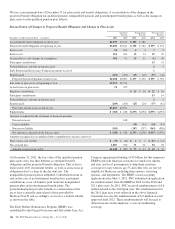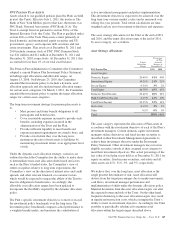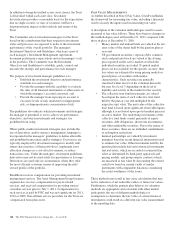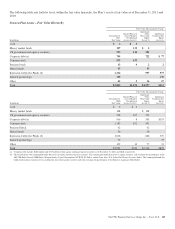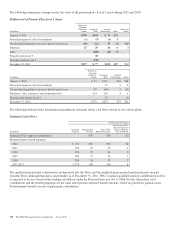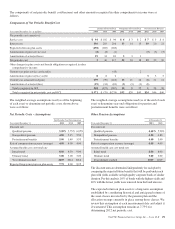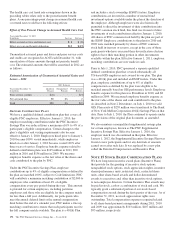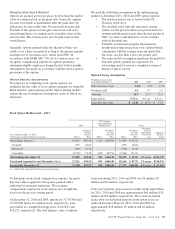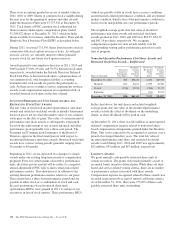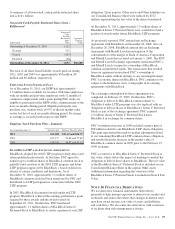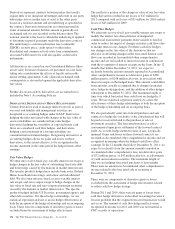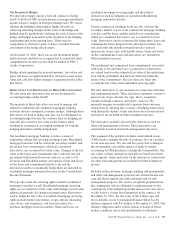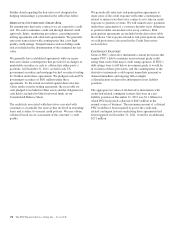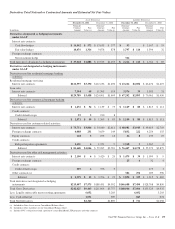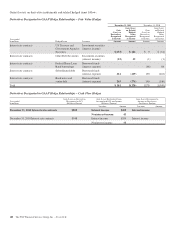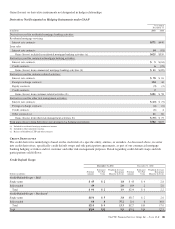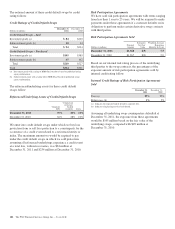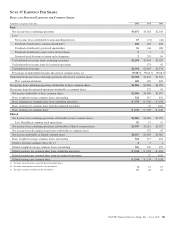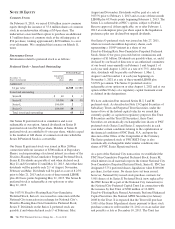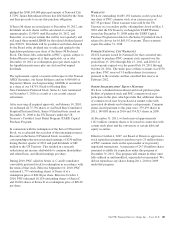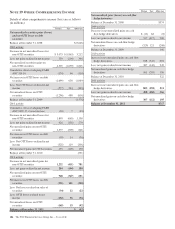PNC Bank 2011 Annual Report Download - page 185
Download and view the complete annual report
Please find page 185 of the 2011 PNC Bank annual report below. You can navigate through the pages in the report by either clicking on the pages listed below, or by using the keyword search tool below to find specific information within the annual report.Derivatives represent contracts between parties that usually
require little or no initial net investment and result in one party
delivering cash or another type of asset to the other party
based on a notional amount and an underlying as specified in
the contract. Derivative transactions are often measured in
terms of notional amount, but this amount is generally not
exchanged and it is not recorded on the balance sheet. The
notional amount is the basis to which the underlying is applied
to determine required payments under the derivative contract.
The underlying is a referenced interest rate (commonly
LIBOR), security price, credit spread or other index.
Residential and commercial real estate loan commitments
associated with loans to be sold also qualify as derivative
instruments.
All derivatives are carried on our Consolidated Balance Sheet
at fair value. Derivative balances are presented on a net basis
taking into consideration the effects of legally enforceable
master netting agreements. Cash collateral exchanged with
counterparties is also netted against the applicable derivative
fair values.
Further discussion on how derivatives are accounted for is
included in Note 1 Accounting Policies.
D
ERIVATIVES
D
ESIGNATED IN
H
EDGE
R
ELATIONSHIPS
Certain derivatives used to manage interest rate risk as part of
our asset and liability risk management activities are
designated as accounting hedges under GAAP. Derivatives
hedging the risks associated with changes in the fair value of
assets or liabilities are considered fair value hedges,
derivatives hedging the variability of expected future cash
flows are considered cash flow hedges, and derivatives
hedging a net investment in a foreign subsidiary are
considered net investment hedges. Designating derivatives as
accounting hedges allows for gains and losses on those
derivatives, to the extent effective, to be recognized in the
income statement in the same period the hedged items affect
earnings.
Fair Value Hedges
We enter into receive-fixed, pay-variable interest rate swaps to
hedge changes in the fair value of outstanding fixed-rate debt
and borrowings caused by fluctuations in market interest rates.
The specific products hedged may include bank notes, Federal
Home Loan Bank borrowings, and senior and subordinated
debt. We also enter into pay-fixed, receive-variable interest
rate swaps, and zero-coupon swaps to hedge changes in the
fair value of fixed rate and zero-coupon investment securities
caused by fluctuations in market interest rates. The specific
products hedged include US Treasury, government agency and
other debt securities. For these hedge relationships, we use
statistical regression analysis to assess hedge effectiveness at
both the inception of the hedge relationship and on an ongoing
basis. There were no components of derivative gains or losses
excluded from the assessment of hedge effectiveness.
The ineffective portion of the change in value of our fair value
hedge derivatives resulted in net losses of $17 million for
2011 compared with net losses of $31 million for 2010 and net
losses of $43 million for 2009.
Cash Flow Hedges
We enter into receive-fixed, pay-variable interest rate swaps to
modify the interest rate characteristics of designated
commercial loan interest payments from variable to fixed in
order to reduce the impact of changes in future cash flows due
to market interest rate changes. For these cash flow hedges,
any changes in the fair value of the derivatives that are
effective in offsetting changes in the forecasted interest cash
flows are recorded in Accumulated other comprehensive
income and are reclassified to interest income in conjunction
with the recognition of interest receipts on the loans. In the 12
months that follow December 31, 2011, we expect to
reclassify from the amount currently reported in Accumulated
other comprehensive income net derivative gains of $382
million pretax, or $248 million after-tax, in association with
interest receipts on the hedged loans. This amount could differ
from amounts actually recognized due to changes in interest
rates, hedge de-designations, and the addition of other hedges
subsequent to December 31, 2011. The maximum length of
time over which forecasted loan cash flows are hedged is 9
years. We use statistical regression analysis to assess the
effectiveness of these hedge relationships at both the inception
of the hedge relationship and on an ongoing basis.
We also periodically enter into forward purchase and sale
contracts to hedge the variability of the consideration that will
be paid or received related to the purchase or sale of
investment securities. The forecasted purchase or sale is
consummated upon gross settlement of the forward contract
itself. As a result, hedge ineffectiveness, if any, is typically
minimal. Gains and losses on these forward contracts are
recorded in Accumulated other comprehensive income and are
recognized in earnings when the hedged cash flows affect
earnings. In the 12 months that follow December 31, 2011, we
expect to reclassify from the amount currently reported in
Accumulated other comprehensive loss, net derivative gains
of $72 million pretax, or $47 million after-tax, as adjustments
of yield on investment securities. The maximum length of
time we are hedging forecasted purchases is four months.
There were no amounts in Accumulated other comprehensive
income related to the forecasted sale of securities at
December 31, 2011.
There were no components of derivative gains or losses
excluded from the assessment of hedge effectiveness related
to either cash flow hedge strategy.
During 2011 and 2010, there were no gains or losses from
cash flow hedge derivatives reclassified to earnings because it
became probable that the original forecasted transaction would
not occur. The amount of cash flow hedge ineffectiveness
recognized in income for 2011 and 2010 was not material to
PNC’s results of operations.
176 The PNC Financial Services Group, Inc. – Form 10-K


